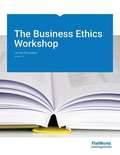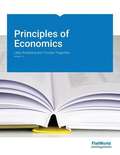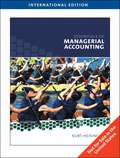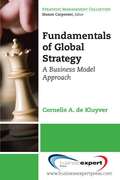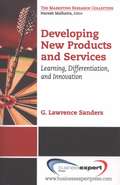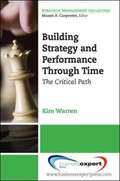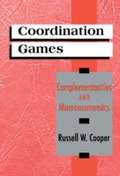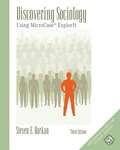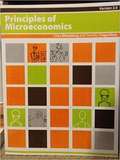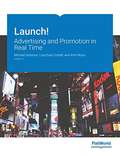- Table View
- List View
Introduction to Psychology
by Charles StangorWhen you teach Introduction to Psychology, do you find it difficult -- much harder than teaching classes in statistics or research methods? Do you easily give a lecture on the sympathetic nervous system, a lecture on Piaget, and a lecture on social cognition, but struggle with linking these topics together for the student? Do you feel like you are presenting a laundry list of research findings rather than an integrated set of principles and knowledge? Have you wondered how to ensure your course is relevant to your students? If so, then you have something in common with Charles Stangor. Charles Stangor's Introduction to Psychology utilizes the dual theme of behavior and empiricism to make psychology relevant to intro students. Charles wrote this book to help students organize their thinking about psychology at a conceptual level. Five or ten years from now, he does not expect his students to remember the details of most of what he teaches them.
The Business Ethics Workshop v 1.0
by James BrusseauOn a good day in the business ethics classroom discussion charges forward; students have read the assigned case study, they're engaged by the conflict and want to work through it. Then, there's a bad day: students didn't bother to do the reading and the hour sags listlessly. The key to going the first way is case studies that students want to read, and The Business Ethics Workshop by James Brusseau provides them with reality and engagement. Reality: No stilted and contrived stories about Steve Smith and Jane Jones. Excerpts from blogs and newspapers bring the weight--and provocation--of the world as it's actually happening to the classroom.
Principles of Economics v 1.1
by Libby Rittenberg Timothy TregarthenVersion 1.1 boasts improved coverage throughout the text including significant updates to: Chapters 20 (GDP, Price Level Changes, Business Cycles, and Unemployment) Chapter 21 (Measuring Total Output and Income) Chapter 27 (Government and Fiscal Policy) Chapter 32 (Macroeconomics for the 21st Century).
The Power of Selling
by Kim RichmondThe Power of Selling is the perfect textbook to teach students about the proven process of selling. More important, it teaches students how to apply the tenets of selling to how to sell themselves and get the job they want, with the same process professional sales people learn (or brush up) on their own selling skills. What makes someone successful in sales? Are great sales people born or made? Is there one magic selling process, or does the process change based on the business...or the customer? How can the selling process really come alive for students in the classroom? How do students learn how to sell for life, not just for a course? The Power of Selling by Kim Richmond answers these questions and makes the principles of selling come alive. Kim looks at the topic of selling through a different lens, and provides inspiration and ideas. The Power of Selling provides an exciting and interactive experience for both professors and students through the use of 4 unique elements: 1. Content The content is based on the core selling tenets so instructors will find the familiar principles of selling. In addition, the impact of Sales 2.0 is addressed at every stage including how to use interactive tools such as Twitter, LinkedIn, Facebook, blogs, and wikis effectively. 2. Selling U The last section of each chapter is called Selling U. It applies the concepts covered in the chapter to a student's job search. Selling U topics include how to think about yourself as a brand, how to create a powerful cover letter and resume, how to create your personal elevator pitch, how to use networking and informational interviews to get the word out about your brand, how to prepare and dress for an interview, and how to negotiate and accept the right job offer. What makes The Power of Selling different is that Selling U is integrated into every chapter, which makes this text the ultimate guide to selling yourself. 3. Video Resources Videos are used throughout the book. Additional videos that are not included in the text are available for instructor use. Here are videos that are available: * Video Ride-alongs - One of the best ways to learn about sales is by going on ride-alongs. So every chapter starts with an exclusive feature called a Video Ride-along. These short videos feature seven different sales professionals - one that starts each chapter. Each one talks about how he or she applies one of the key concepts covered in the chapter in their job. These videos are designed to be "virtual ride-alongs" so the students can actually feel as though they are getting insights first hand from selling professionals. * The Power of Selling YouTube Channel here (youtube.com/thepowerofselling) - Over 50 videos are included featuring the sales professionals who are highlighted in the Video Ride-alongs. About half of the videos are used in the textbook. The balance are available for instructor use. Several are included in Video Learning Segments (see below). These videos are excellent resources for use in the classroom, exercises, and assignments. * Video Learning Segments In addition to the traditional supplements of Instructor Manual, PowerPoints, and Test Bank, there are also Video Learning Segments. These are PowerPoint slides embedded with videos designed to supplement the course PowerPoints and focus on one concept, like an ethical dilemma, pre-call preparation, or effective presentations, how to use email effectively. Each segment includes slides, videos, discussion questions, or exercises. 4. The Power of Selling LinkedIn Group. here This group was created on LinkedIn.com expressly as a resource for the faculty and students who use this textbook. The group includes sales professionals from across the country and from different industries. This is a great tool for faculty and students alike to network, participate in discussions, ask questions, and connect with "real world" selling professionals.
Information Systems: A Manager's Guide to Harnessing Technology - Version 1.1
by John GallaugherInformation Systems: A Manager's Guide to Harnessing Technology is intended for use in undergraduate and/or graduate courses in Management Information Systems and Information Technology. One of BusinessWeek's "Professors of the Year", John Gallaugher of Boston College, brings you a brand new Management Information Systems textbook that teaches students how he or she will experience IS from a Managers perspective first hand through interesting coverage and bleeding-edge cases. Get involved with John's community by visiting and subscribing to his blog, The Week In Geek, where courseware, technology and strategy intersect and joining his Ning IT Community site where you can get more resources to teach Information Systems. Shockingly, at a time when technology regularly appears on the cover of every major business publication, students find IS among the least appealing of management disciplines. The teaching approach in Information Systems: A Manager's Guide to Harnessing Technology can change this. The text offers a proven approach that has garnered student praise, increased IS enrollment, and engaged students to think deeper and more practically about the space where business and technology meet. Every topic is related to specific business examples, so students gain an immediate appreciation of its importance. Rather than lead with technical topics, the book starts with strategic thinking, focusing on big-picture issues that have confounded experts but will engage students. And while chapters introduce concepts, cases on approachable, exciting firms across industries further challenge students to apply what they've learned, asking questions like: Why was NetFlix able to repel Blockbuster and WalMart? How did Harrah's Casino's become twice as profitable as comparably-sized Caesar's, enabling the former to acquire the latter? How does Spain's fashion giant Zara, a firm that shuns the sort of offshore manufacturing used by every other popular clothing chain, offer cheap fashions that fly off the shelves, all while achieving growth rates and profit margins that put Gap to shame? What's an IPO and can a technology alternative push out investment bankers and insiders to the benefit of entrepreneurs and small investors? Why is Google more profitable than Disney? Is Facebook really worth $15 billion? The Information Systems course and discipline have never seemed more relevant, more interesting, and more exciting. Gallaugher's textbook can help teachers make students understand why.
Managerial Accounting
by Kurt Heisinger Joe HoyleKurt Heisinger and Joe Ben Hoyle believe that students want to learn accounting in the most efficient way possible, balancing coursework with personal schedules. They tend to focus on their studies in short intense segments between jobs, classes, and family commitments. Meanwhile, the accounting industry has endured dramatic shifts since the collapse of Enron and WorldCom, causing a renewed focus on ethical behavior in accounting. This dynamic author team designed Managerial Accounting to work within the confines of today’s students’ lives while delivering a modern look at managerial accounting. Managerial Accounting was written around three major themes: Ready, Reinforcement and Relevance. This book is aimed squarely at the new learning styles evident with today’s students and addresses accounting industry changes as well.
Principles of Marketing 2.0
by Mary Anne Raymond Jeff TannerPrinciples of Marketing Version 2.0 by Tanner, Raymond and Schuster teaches the experience and process of actually doing marketing - not just the vocabulary. It carries five dominant themes throughout in order to expose students to marketing in today's environment: Service dominant logic - This textbook employs the term "offering" instead of the more traditional First "P" -- product. That is because consumers don't sacrifice value when alternating between a product and a service. They are evaluating the entire experience, whether they interact with a product, a service, or a combination. So the fundamental focus is providing value throughout the value chain, whether that value chain encompasses a product, service, or both. Sustainability; Increasingly, companies are interested in the impact they are having on their local community as well as the overall environment. This is often referred to as the triple bottom line of financial, social, and environment performance. Ethics and social responsibility; Following on the sustainability notion is the broader importance of ethics and social responsibility in creating successful organizations. The authors make consistent references to ethical situations throughout chapter coverage, and end of chapter material in most chapters will encompass ethical situations. Global coverage -- Tanner, Raymond and Schuster deliberately entitled Chapter 1; What is Marketing?; Whether it is today's price of gasoline, the current U.S. presidential race, or Midwestern U.S. farming, almost every industry and company needs strong global awareness. And today's marketing professionals must understand the world in which they and their companies operate. Metrics -- Firms today have the potential to gather more information than ever before about their current and potential customers. That information gathering can be costly, but it can also be very revealing. With the potential to capture so much more detail about micro transactions, firms should now be more able to answer ;well, what this marketing strategy really worth it?; And what is the marketing ROI?; And finally, what is this customer or set of customers worth to us over their lifetime? Principles of Marketing Version 2.0 brings new and updated coverage of new developments in the influence of social media to empower consumers, as well as marketing's use of social media, such as sentiment analysis, mobile marketing, and customer service and complaint tracking, as a communications and promotion channel, just a name a few. Version 2.0 also has an overall increased number of examples, as well as, new discussion questions in every chapter (resulting in at least 10 per chapter). In addition, the textbook's key terms, and repeated concepts have been strategically arranged to make customizing this book with Flat World's MIYO platform even easier.
Money and Banking
by Robert E. WrightThe financial crisis of 2007-8 has already revolutionized institutions, markets, and regulation. Wright's Money and Banking V 2.0 captures those revolutionary changes and packages them in a way that engages undergraduates enrolled in Money and Banking and Financial Institutions and Markets courses.
Business Law and the Legal Environment
by Don Mayer Daniel M. Warner George J. Siedel Jethro K. LiebermanMayer, Warner, Siedel and Lieberman's Business Law and the Legal Environment is an up-to-date textbook with comprehensive coverage of legal and regulatory issues -- and organized to permit instructors to tailor the materials to their particular approach. The authors take special care to engage students by relating law to everyday events with which they are already familiar with their clear, concise and readable style. Business Law and the Legal Environment provides students with context and essential concepts across the entire range of legal issues with which managers and business executives must grapple. The texts provide the vocabulary and legal acumen necessary for business people to talk in an educated way to their customers, employees, suppliers, government officials -- and to their own lawyers.
Exploring Business
by Karen CollinsCollins is the only Introduction to Business book to teach students the topics of business through an in-depth study of a single company--Nike. How do you show your students the relationships between what they are learning in the classroom and what happens in the real business world? What happens when your students don't see the connections between the theory they are learning in the classroom and what is happening in the real business world?
Fundamentals of Global Strategy
by Cornelis A. de KluyverThis book looks at the opportunities and risks associated with staking out a global competitive presence and introduces the fundamentals of global strategic thinking. We define crafting a global strategy in terms of change: how a company should change and adapt its core (domestic) business model to achieve a competitive advantage as it expands globally. The conceptual framework behind this definition has three fundamental building blocks: a company's core business model, the various strategic decisions a company needs to make as it globalizes its operations, and a range of globalization strategies for creating a global competitive advantage. A business model is defined in terms of four principal components: (a) market participation--who its customers are, how it reaches them and relates to them; (b) the value proposition--what a company offers its customers; (c) the supply chain infrastructure--with what resources, activities and partners it creates its offerings; and finally, (d) its management model--how it organizes and coordinates its operations. Globalization requires a company to make strategic decisions about each component of the business model. Market participation decisions include choosing which specific markets or segments to serve, domestically or abroad; what methods of distribution to use to reach target customers; and how to promote and advertise the value proposition. Globalization decisions about the value proposition touch the full range of tangible and intangible benefits a company provides to its customers (stakeholders). Decisions about a company's value chain infrastructure deal with such questions as, What key internal resources and capabilities has the company created to support the chosen value proposition and target markets? What partner network has it assembled to support the business model? How are these activities organized into an overall, coherent value creation and delivery model? Finally, strategic decisions about the global management dimension are concerned with a company's choices about a suitable global organizational structure and decision-making process. We use Pankaj Ghemawat's well-known "AAA Triangle" framework to define three generic approaches to global value creation. Adaptation strategies seek to increase revenues and market share by tailoring one or more components of a company's business model to suit local requirements or preferences. Aggregation strategies focus on achieving economies of scale or scope by creating regional or global efficiencies; they typically involve standardizing a significant portion of the value proposition and grouping together development and production processes. Arbitrage is about exploiting economic or other differences between national or regional markets, usually by locating separate parts of the supply chain in different places.
Developing New Products and Services
by G. Lawrence SandersThe focus of the book is on the up-front activities and ideas for new product and service development. A central theme of this book is that there is, or should be, a constant struggle going on in every organization, business, and system between delivering feature-rich versions of products and services using extravagant engineering and delivering low-cost versions of products and services using frugal engineering. Delivering innovative products is accomplished by an endless cycle of business planning, creative and innovative insight, and learning-about and learning-by-doing activities. A number of powerful concepts and tools are presented in the book to facilitate new product development. For example, three templates are presented that facilitate new product and service development. The FAD (features, attributes, and design) template is used to identify the features and attributes that can be used for product and service differentiation. The Ten-Ten planning process contains two templates: an Organizational and Industry Analysis template and the Business Plan Overview template. These two templates coupled with the FAD template can be used to develop a full-blown business plan. Entrepreneurship, technology and product life cycles, product and service versioning, product line optimization, creativity, lock-in real options, business valuation, and project management topics are also covered.
Building Strategy and Performance
by Kim WarrenThe fundamental challenge facing business leaders is to drive performance into the future--the dynamics of strategy. To tackle this effectively, they need a clear understanding of what causes performance to improve or deteriorate and what power they have to change this trajectory for the better. Without this understanding, they risk making poor choices about their future--failing to exploit promising opportunities, pursuing unachievable aims, or falling victim to competitive and other threats. Building Strategy and Performance Through Time sets the agenda for building business strategy in powerful, actionable, and accessible terms. It gives executives clear frameworks for answering three fundamental questions: * Why is our business performance following its current path? * Where is it going if we carry on as we are? * How can we design a robust strategy to transform this future? The existing strategy tools most widely used help guide management's choices about where to compete--which customers to serve, with what products and services, and how to deliver those products and services to those customers effectively and profitably. While this choice is important, it is not often changed in any fundamental way; having found a reasonably strong and profitable position on these issues, few firms will, or should, set off in a new direction. But there is still much to be done to deliver that strategy, powerfully and sustainably over time. Many decisions need to be made, continually and holistically, across all functions of the business and adapted as conditions change from month to month and year to year. Pricing, product development, marketing, hiring, service levels, and other decisions cannot be made in isolation but must take into account other choices being made, elsewhere and at different times. Building Strategy and Performance Through Time explains a reliable, practical method, known as strategy dynamics, that creates a living picture of how an enterprise actually works and delivers performance. This picture shows exactly where the levers are that management controls and how to choose what to do, when, and how much, to accomplish your specific goals. It shows, too, how the same approach can be used to defeat competitors, cope with other outside forces, and keep delivering performance.
General Chemistry
by Bruce Averill Patricia EldredgeThe overall goal of the authors with General Chemistry: Principles, Patterns, and Applications was to produce a text that introduces the students to the relevance and excitement of chemistry. Although much of first-year chemistry is taught as a service course, Bruce and Patricia feel there is no reason that the intrinsic excitement and potential of chemistry cannot be the focal point of the text and the course. So, they emphasize the positive aspects of chemistry and its relationship to students' lives, which requires bringing in applications early and often. In addition, the authors feel that many first year chemistry students have an enthusiasm for biologically and medically relevant topics, so they use an integrated approach in their text that includes explicit discussions of biological and environmental applications of chemistry. Topics relevant to materials science are also introduced to meet the more specific needs of engineering students.
Macroeconomics
by Russell Cooper A. Andrew JohnThis book studies the implications of macroeconomic complementarities for aggregate behavior. The presentation is intended to introduce Ph. D. students into this sub-field of macroeconomics and to serve as a reference for more advanced scholars. The initial sections of the book cover the basic framework of complementarities and provide a discussion of the experimental evidence on the outcome of coordination games. The subsequent sections of the book investigate applications of these ideas for macroeconomics. The topics Professor Cooper explores include: economies with production complementarities, search models, imperfectly competitive product markets, models of timing and delay and the role of government in resolving and creating coordination problems.
Sociology
by Steven E. BarkanThis best selling software-based workbook lets students explore dozens of sociological topics and issues, using data from the United States and around the world. With the workbook and accompanying ExplorIt software and data sets, students won't just read about what other sociologists have done, they will discover sociology for themselves. DISCOVERING SOCIOLOGY will add an exciting dimension to the introductory sociology course.
Sustainability, Innovation, and Entrepreneurship
by Andrea LarsonThis book is suited for the Entrepreneurship or Innovation course with an emphasis on Sustainability or for a course devoted entirely to Sustainability. The deep roots of sustainability thinking are now evident in widespread and increasingly visible activities worldwide, this text will help you and your students explore that necessity, its implications and its progression.
Principles of Macroeconomics
by Libby Rittenberg Timothy TregarthenFlat World Knowledge is honored to publish a new, first edition re-launch of Tim Tregarthen's wonderful principles of macroeconomics book, and proud to bring Tim's incredible talents as a teacher back to life so future generations of students can continue to learn from him. In 1996, he published the first edition of his principles of microeconomics textbook to great acclaim, and it became widely used in colleges around the country. That same year, MS made him wheelchair-bound. The disease forced his retirement from teaching at the University of Colorado at Colorado Springs in 1998. He lost the use of his arms in 2001 and has been quadriplegic ever since. Tim never let his disease get him down. In fact, he turned back to his love of writing and teaching for inspiration. He obtained a voice-activated computer, recruited a co-author, Libby Rittenberg of Colorado College, and turned his attention to revising his principles of economics book. Today we are excited to introduce Libby Rittenberg and Timothy Tregarthen's Principles of Macroeconomics. The authors teach economics as the study of "choice " by providing students with an accessible, straightforward overview of economics. This text combines the clarity and writing of Tregarthen's seminal periodical "The Margin" with great teaching insights. Rittenberg and Tregarthen help students to understand how real individuals actually work with economics. In this new book, the authors illustrate the practicality and relevance of economics with a variety of new illustrations and insights. The authors take a three-pronged approach to every concept: (1) the concept is covered with a "Heads Up" to ward off confusion, (2) a "You Try It" section makes sure students are staying on top of the concept and (3) a "Case and Point" section that uses a real-world application to harness the concept in reality. For one example of how this plays out in the text see "Chapter 3, Section 2 on Supply".here This book is intended for a one-semester course in Macroeconomics taught out the social sciences or business school.
Personal Finance
by Rachel Siegel Carol YachtPersonal Finance by Rachel Siegel and Carol Yacht is a comprehensive Personal Finance text which includes a wide range of pedagogical aids to keep students engaged and instructors on track. If you would like to hear Rachel talk about her book, and the Personal Finance course listen here to her podcast. This book is arranged by learning objectives. The headings, summaries, reviews, and problems all link together via the learning objectives. This helps instructors to teach what they want, and to assign the problems that correspond to the learning objectives covered in class. Personal Finance includes personal finance planning problems with links to solutions, and personal application exercises, with links to their associated worksheet(s) or spreadsheet(s). In addition, the text boasts a large number of links to videos, podcasts, experts' tips or blogs, and magazine articles to illustrate the practical applications for concepts covered in the text. Finally, the modular nature of the chapters lends itself to the Flat World Knowledge publishing model allowing instructors to adapt the textbook to the exact needs of their specific class and student body.
Introduction to Economic Analysis
by R. Preston Mcafee Tracy R. LewisThis book presents standard intermediate microeconomics material and some material that, in the authors' view, ought to be standard but is not. Introductory economics material is integrated. Standard mathematical tools, including calculus, are used throughout. The book easily serves as an intermediate microeconomics text, and can be used for a relatively sophisticated undergraduate who has not taken a basic university course in economics. The focus of this book is on the conceptual tools and not on fluff. As such, it reflects the approach actually adopted by the majority of economists for understanding economic activity. There are lots of models and equations, and no pictures of economists ;-) Economic analysis is used in many situations. When British Petroleum sets the price for Alaskan crude oil, it uses an estimated demand model, both for gasoline consumers and also for the refineries to which BP sells. Economic analysis was used by experts in the antitrust suit brought by the U.S. Department of Justice both to understand Microsoft s incentive to foreclose (eliminate from the market) rival Netscape and consumer behavior in the face of alleged foreclosure. Stock market analysts use economic models to forecast the profits of companies to predict the price of their stocks. When the government forecasts the budget deficit or considers a change in environmental regulations, it uses economic models. This book presents the building blocks of the models in common use by an army of economists thousands of times per day. This book, plus econometrics, provides most of the economic analysis tools to take upper division economics courses of any type.
Money and Banking
by Robert E. WrightThe financial crisis of 2007-8 has already revolutionized institutions, markets, and regulation. Wright's Money and Banking V 2.0 captures those revolutionary changes and packages them in a way that engages undergraduates enrolled in Money and Banking and Financial Institutions and Markets courses.
Principles of Management
by Mason Carpenter Talya Bauer Berrin ErdoganPrinciples of Management by Carpenter, Bauer and Erdogan teaches management principles to tomorrow's business leaders by weaving three threads through every chapter: strategy, entrepreneurship and active leadership. Strategic: All business school teachings have some orientation toward performance and strategy and are concerned with making choices that lead to high performance. Principles of Management will frame performance using the notion of the triple bottom-line the idea that economic performance allows individuals and organizations to perform positively in social and environmental ways as well. The triple bottom line is financial, social, and environmental performance. It is important for all students to understand the interdependence of these three facets of organizational performance. The Entrepreneurial Manager: While the General Management course at Harvard Business School was historically one of its most popular and impactful courses (pioneered in the 1960s by Joe Bower), recent Harvard MBAs did not see themselves as general managers. This course was relabeled 'The Entrepreneurial Manager' in 2006, and has regained its title as one of the most popular courses. This reflects and underlying and growing trend that students, including the undergraduates this book targets, can see themselves as entrepreneurs and active change agents, but not just as managers. By starting fresh with an entrepreneurial/change management orientation, this text provides an exciting perspective on the art of management that students can relate to. At the same time, this perspective is as relevant to existing for-profit organizations (in the form intrapreneurship) as it is to not-for-profits and new entrepreneurial ventures. Active Leadership: Starting with the opening chapter, Principles of Management show students how leaders and leadership are essential to personal and organizational effectiveness and effective organizational change. Students are increasingly active as leaders at an early age, and are sometimes painfully aware of the leadership failings they see in public and private organizations. It is the leader and leadership that combine the principles of management (the artist's palette, tools, and techniques) to create the art of management. Cases: Mason provides brief cases in his Instructors Manual for those who take a case approach to the course or who wish to incorporate cases. This book's modular format easily maps to a POLC course organization (Planning, Organizing, Leading, and Controlling, attributed to Henri Fayol (1949, General and industrial management. London. Pitman Publishing company), and suits the needs of most undergraduate or graduate course in Principles of Management.
Organizational Behavior v 1.1
by Talya Bauer Berrin ErdoganTwo leading researchers in Management, Talya Bauer and Berrin Erdogan, bring you a new Organizational Behavior textbook that bridges the gap between theory and practice with a distinct "experiential" approach. On average, a worker in the USA will change jobs 10 times in 20 years. In order to succeed in this type of career situation, individuals need to be armed with the tools necessary to be life-long learners. To that end, this book is not be about giving students all the answers to every situation they may encounter when they start their first job or as they continue up the career ladder.
Principles of Microeconomics 2.0
by Libby Rittenberg Timothy TregarthenFlat World Knowledge is honored to publish Version 2.0 (an orginal re-launch) of Tim Tregarthen's wonderful principles of microeconomics book, and proud to bring Tim's incredible talents as a teacher back to life so future generations of students can continue to learn from him.
Launch! Advertising and Promotion in Real Time
by Michael Solomon Lisa Duke Cornell Amit NizanLaunch! is written for advertising and promotions courses taught to students in the business school and journalism & mass communication students. This book is the first of its kind to teach advertising concepts by reverse engineering a real advertising campaign from beginning to end. In April 2007, SS+K, an innovative New York City communications agency, launched the first ever branding campaign for msnbc.com with the tag "A Fuller Spectrum of News." Launch! follows that campaign from initial agency pitch through roll-out of print and media assets to post-campaign analysis. Throughout, it exposes readers to the theory and concepts of advertising and promotion, and the personalities and decisions that drove this campaign. The book takes a rare look "behind the curtain" - even letting you see some of the paths not chosen by the agency and client. Students get a realistic sense of how theory plays out in practice. They get a flavor for the exciting field of advertising. And, they consistently learn the perspectives of both the advertising agency (where many journalism and communications students will work) and the client (where many marketing majors will work). This is a unique book, with a unique perspective, by a unique author team, and you won't find this kind of insight in any other text on the market.

